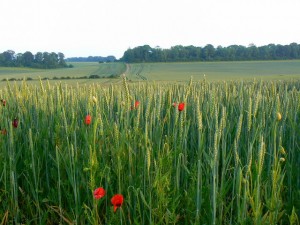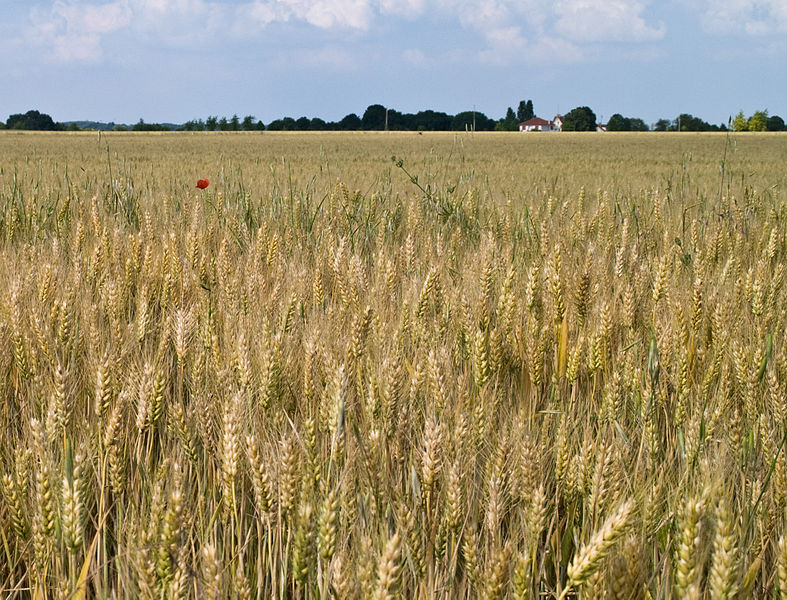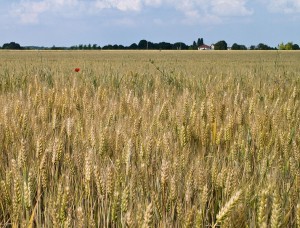As mentioned previously on the blog, Andrew Jackson and I started a new module this year called “Research Comprehension”. The module revolves around our Evolutionary Biology and Ecology seminar series and the continuous assessment for the module is in the form of blog posts discussing these seminars. We posted a selection of these earlier in the term, but now that the students have had their final degree marks we wanted to post the blogs with the best marks. This means there are more blog posts for some seminars than for others, though we’ve avoided reposting anything we’ve posted previously. We hope you enjoy reading them, and of course congratulations to all the students of the class of 2014! – Natalie
Here are Yutaka Kumagai and Cormac Murphy’s views on Dr. Fiona Doohan‘s seminar, “Plant-Microbe interactions – the good, the bad and the ugly”.
———————————————————————————-
Food security: A game changer for GMOs?
Yutaka Kumagai
The subject of genetic modification has always carried with it a certain level ethical ambiguity in the eyes of the wider public. While quite a significant proportion of the blame for this may be down to misinformation and ignorance, it may also be contributed to the somewhat shady operations of large corporations such as Monsanto. It is inevitably the more shocking or controversial stories that capture the imaginations of the public, and the David and Goliath legal battles between farmers and corporations do not fail to grab attention. Anti-GMO activist groups are also extremely vocal in their fight for organic produce, and many of the articles that may be sourced online are heavily biased in their favour.
On a national level, public opinion is clearly against the notion of genetically engineered organisms, a simple google search of ‘Ireland GMO’ returns multiple hits from anti-GMO sites. Yet while Irish consumers may not approve of GM, it is obvious that many also do not understand the concept. A certain amount of the blame for this ignorance surely lies with the lack of dialogue surrounding the topic, with most of the information broadcast being anti-GMO, without providing much of an explanation. This may even be seen in large scale shops such as Marks & Spencers lauding their wares as non-GM.
However, the benefits of many GM foods are such that surely a system of control would be more profitable than outright ban. In a recent seminar, Dr. Fiona Doohan, a senior lecturer at UCD, gave an insight into the research being undertaken by her team on disease resistance in cereal crops. Specifically, her works focuses on the infection of wheat and barley crops by Fusarium graminearum and F. culmorum, which are known causes of Fusarium Head Blight (FHB) disease. This causes bleaching of cereal grains, and is harmful to plants and animals. The main toxin produced during infection is deoxynivalenol (DON), which facilitates FHB, and may be attributed as the cause of many of the observable effects. By observing variance in wheat response to DON, Doohan was able to find a resistant genotype. Unfortunately, this resistant genotype carried with it its own set of negative traits, preventing it from use as an effective cash crop. As such, Doohan attempted to identify the specific genes associated with resistance. Expression levels of DON-resistant wheat genes were analysed through the use of microarray testing, with results verified through RT-PCR analysis. This allowed for the identification on orphan (lineage specific) genes involved in the defence pathway activated by DON to be identified. With further research, it will hopefully be possible for this pathogen resistance to be conferred to susceptible wheat strains.
It would be difficult to colour such a development in a bad light, especially considering that wheat is one of the most produced cereal crops in the world. So why is public opinion so against GMO? All GMO food products must pass rigorous testing by the WHO, with continuous assessment taking place once a product is released to the market. While certain GM foods, such as golden rice, do make their way into the public ‘good books’, even these success stories are not as widely known as they ought to be. Yet, it can only be hoped that the current research being undertaken by Doohan, and those like her, will turn the tide in this war of misinformation.
———————————————————————————-
Give us this day our daily bread
Cormac Murphy
Wheat and its by-products have been such an integral part of human livelihoods for so long they’ve become religious artefacts. They are everywhere, just ask a despairing coeliac. But for as long as we’ve been cultivating wheat, our health has been intertwined with that of the crop. Poor weather, mycological diseases or trampling could take both the income and vital nutrition from a family. And if an infected stalk was reaped and processed into food, it could pose a real threat to the health and sanity of a community. Some classic examples are the cases of ergot poisoning that lead to mass hysteria and witch burnings across Europe in the middle ages. Today with wheat representing the second largest source of calories for all mankind, the health of our wheat crop has never been more important.
And it’s up to people like Fiona Doohan, Director of the UCD Earth Institute to cultivate strains of wheat that can produce enough to meet the need of a hungry word (and economy) that are resistant to these harmful pathogens. Dr. Doohan’s lab focused on the fungus Fusarium graminearum, which causes fusarium head blight (fhb) a disease that devastates wheat and barley resulting in billions of dollars loss in crops annually. Dr. Doohan looks at the actions of the fungus focusing on one of the main toxins it produces, deoxynivalenol (DON) also charmingly known as vomitoxin. DOM interferes with protein synthesis and when applied by itself to the wheat heads produced the bleaching characteristic of fhb. In low levels DON has been found to prevent cell death, whereas at high levels DOM causes it. This facilitates the switch from vitotrophic to necrotrophic which is a key part of the disease’s progression and spread. Dr. Doohan looked at 2 cultivars of wheat; Remus which was susceptible to DOM but produces an economically viable crop, and CM 82036 which wile being a less viable source of income is resistant to DON.
Both were treated with DOM. After 4 hours the plants were observed and RNA samples and run through a custom microarray were taken from both plants, this was repeated after 24 hrs. The DON was seen to have a greater effect after 24hrs in the Remus both visibly and in terms of disrupting protein synthesis. In the resistant strain the majority of the proteins that seem to be produced in response to the toxin were “unclassified” the products of “orphan genes”. Orphan genes are genes with very specific lineages that we currently have very little information on in databases. Doohan’s team found that these particular orphans seemed to be linked to stress responses in the plant. There was also evidence that they were fast evolving, with even close phylogenic relatives baring genes with as little as a 50% match. They appeared to be more toxin specific than tissue specific, arising at the points where DON was introduced. These seem like the key to DON resistance and potentially the key to transferring that resistance. A yeast 2 hybrid screen was then used to examine the interactions of these orphan proteins with other proteins known to be active in stress resistance. In these tests a related mycological toxin T-2 was used on the yeast as yeast is highly DON resistant. Just to drive home the seriousness of these toxins T-2 is the key ingredient in now banned biological weapon known as “Yellow rain”. The results of these tests indicated that the orphans are involved in the activation of the SnRK1 stress resistance pathway thought how it interacts remains unknown.
These experiments have given us a glimpse at a potential new tool to protect the food security of the world. But with so little known about the genes involved, a lot of work still needs to be done. Some wheat genomes have recently been sequenced and the information that can be gathered from them may yet shed light on our orphans. As with any GM organism, particularly one that’s intended for human consumption, there must be a great understanding of exactly how these changes will affect the makeup of these plants.
Image: Wikicommons




